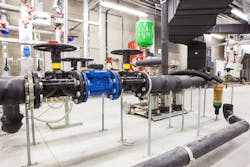What is the measure by which flowmeter performance should be compared?
A. Percent of flow rate
B. Percent of full scale
C. Percent of calibrated span
D. Percent of set span
E. Percent of meter capacity
All of these performance specifications (and more) are found in practice. Explanations of these terms and examples of their use can be found in my company’s various Consumer Guides and in my book Industrial Flow Measurement (ISA Press). In theory, any of these measures could be used for comparison, but some are more cumbersome and difficult to use than others.
The specification used to describe the performance of many flowmeter technologies is a percentage of flow rate (Answer A) within its minimum and maximum flow rates. This form of specification typically results from the absence of a zero adjustment in the fundamental flowmeter measurement. A flowmeter with a percent of rate statement can usually be readily compared with other such flowmeters because the same straightforward specification applies throughout the flow range.
However, the error associated flowmeters expressed as a percent of full scale (Answer B), calibrated span (Answer C), set span (Answer D) and meter capacity (Answer E) is typically a constant measurement error (such as ±1 liters per minute) throughout the flow range. Comparison can be complicated because the measurement error is dependent on a somewhat arbitrary selection of full scale, calibrated span, set span and/or meter capacity.
Fortunately, percent of full scale, calibrated span, set span and meter capacity measurement errors can be converted into percent of flow rate errors at each flow rate of interest and compared. Answer A is correct.
Additional complicating factors
Complete flowmeter performance specifications typically include other influences such as analog output accuracy, voltage effects, ambient temperature effects and process pressure effects that can significantly complicate flowmeter performance calculations.
David W. Spitzer is a regular contributor to Flow Control magazine and a principal in Spitzer and Boyes LLC offering engineering; seminars; strategic marketing consulting; distribution consulting; and expert witness services for manufacturing and automation companies. Spitzer and Boyes is also the publisher of the Industrial Automation INSIDER. Spitzer has more than 40 years of experience and has written more than 10 books and 300 articles about flow measurement, instrumentation and process control. He may be reached at 845-623-1830 or at spitzerandboyes.com.


